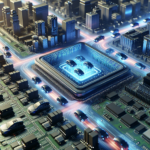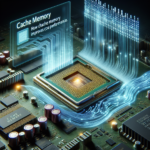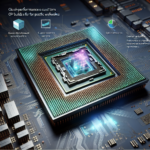The Role of CPUs in Autonomous Vehicles

The Role of CPUs in Autonomous Vehicles
Autonomous vehicles, often referred to as self-driving cars, are at the forefront of technological innovation. These vehicles promise to revolutionize transportation by enhancing safety, reducing traffic congestion, and providing mobility solutions for those unable to drive. At the heart of this technological marvel lies the Central Processing Unit (CPU), a critical component that orchestrates the myriad of tasks required for autonomous driving. This article delves into the role of CPUs in autonomous vehicles, exploring their functions, challenges, and future prospects.
Understanding Autonomous Vehicles
What Are Autonomous Vehicles?
Autonomous vehicles are equipped with advanced sensors, cameras, and artificial intelligence (AI) systems that allow them to navigate and operate without human intervention. These vehicles rely on a combination of hardware and software to perceive their environment, make decisions, and execute driving tasks.
Levels of Autonomy
The Society of Automotive Engineers (SAE) defines six levels of vehicle autonomy, ranging from Level 0 (no automation) to Level 5 (full automation). Each level represents a step towards complete autonomy:
- Level 0: No automation. The driver is responsible for all driving tasks.
- Level 1: Driver assistance. The vehicle can assist with either steering or acceleration/deceleration, but not both simultaneously.
- Level 2: Partial automation. The vehicle can control both steering and acceleration/deceleration, but the driver must remain engaged and monitor the environment.
- Level 3: Conditional automation. The vehicle can perform all driving tasks under certain conditions, but the driver must be ready to take control when requested.
- Level 4: High automation. The vehicle can perform all driving tasks in specific conditions without human intervention.
- Level 5: Full automation. The vehicle can perform all driving tasks under all conditions without human intervention.
The Role of CPUs in Autonomous Vehicles
Central Processing Unit (CPU) Overview
The CPU is the brain of any computing system, responsible for executing instructions and processing data. In autonomous vehicles, the CPU plays a pivotal role in managing the complex computations required for real-time decision-making and control.
Key Functions of CPUs in Autonomous Vehicles
CPUs in autonomous vehicles are tasked with several critical functions:
- Data Processing: Autonomous vehicles generate vast amounts of data from sensors, cameras, and other sources. The CPU processes this data to create a comprehensive understanding of the vehicle’s surroundings.
- Decision-Making: The CPU runs complex algorithms and AI models to make real-time decisions, such as identifying obstacles, determining the optimal path, and executing maneuvers.
- Control Systems: The CPU interfaces with the vehicle’s control systems to manage acceleration, braking, and steering based on the decisions made by the AI models.
- Communication: The CPU facilitates communication between various components of the autonomous vehicle, ensuring seamless coordination and operation.
Data Processing and Sensor Fusion
Autonomous vehicles rely on a variety of sensors, including LiDAR, radar, cameras, and ultrasonic sensors, to perceive their environment. Each sensor provides different types of data, such as distance measurements, object detection, and environmental mapping. The CPU is responsible for processing and integrating this data through a process known as sensor fusion.
Sensor fusion combines data from multiple sensors to create a unified and accurate representation of the vehicle’s surroundings. This process involves complex mathematical computations and algorithms, which the CPU must execute in real-time to ensure safe and efficient operation.
Artificial Intelligence and Machine Learning
AI and machine learning are at the core of autonomous vehicle technology. These systems enable the vehicle to learn from data, recognize patterns, and make informed decisions. The CPU plays a crucial role in running AI models and machine learning algorithms, which require significant computational power.
Deep learning, a subset of machine learning, is particularly important for tasks such as object detection, image recognition, and natural language processing. CPUs, often in conjunction with Graphics Processing Units (GPUs) and specialized AI accelerators, handle the intensive computations required for deep learning models.
Real-Time Decision-Making
One of the most challenging aspects of autonomous driving is real-time decision-making. The CPU must process sensor data, run AI models, and make decisions within milliseconds to ensure the vehicle can respond to dynamic and unpredictable environments.
For example, if a pedestrian suddenly steps into the road, the CPU must quickly analyze the situation, determine the appropriate response (e.g., braking or swerving), and execute the necessary actions. This requires a high level of computational efficiency and reliability.
Challenges and Considerations
Computational Power and Efficiency
Autonomous vehicles require immense computational power to process data and run AI models in real-time. CPUs must be capable of handling these demands while maintaining energy efficiency, as excessive power consumption can impact the vehicle’s range and performance.
Latency and Real-Time Performance
Latency, or the delay between data input and processing output, is a critical factor in autonomous driving. High latency can result in delayed responses, potentially compromising safety. CPUs must be optimized for low-latency performance to ensure timely decision-making and control.
Reliability and Safety
Autonomous vehicles must operate reliably under various conditions and scenarios. CPUs must be designed to handle hardware failures, software bugs, and other potential issues without compromising safety. Redundancy and fail-safe mechanisms are essential to ensure continuous operation.
Integration with Other Components
The CPU is just one part of the autonomous vehicle’s computing architecture. It must seamlessly integrate with other components, such as GPUs, AI accelerators, and communication modules, to deliver optimal performance. This requires careful design and coordination between hardware and software systems.
Future Prospects and Innovations
Advancements in CPU Technology
As autonomous vehicle technology continues to evolve, so too will CPU technology. Future CPUs are expected to offer greater computational power, energy efficiency, and specialized features tailored for autonomous driving. Innovations such as neuromorphic computing and quantum computing hold promise for further enhancing the capabilities of autonomous vehicles.
Integration with Edge Computing
Edge computing involves processing data closer to the source, reducing latency and bandwidth requirements. Autonomous vehicles can benefit from edge computing by offloading certain tasks to edge nodes, allowing the CPU to focus on critical real-time computations. This approach can enhance overall performance and efficiency.
Collaboration with AI Accelerators
AI accelerators, such as GPUs and Tensor Processing Units (TPUs), are designed to handle the intensive computations required for AI and machine learning. By collaborating with these accelerators, CPUs can offload specific tasks, improving overall performance and enabling more advanced AI models.
FAQ
What is the primary role of the CPU in an autonomous vehicle?
The primary role of the CPU in an autonomous vehicle is to process data from sensors, run AI models for decision-making, manage control systems, and facilitate communication between various components. It acts as the central hub for executing the complex computations required for autonomous driving.
How do CPUs handle the vast amounts of data generated by autonomous vehicles?
CPUs handle the vast amounts of data generated by autonomous vehicles through a process called sensor fusion. This involves integrating data from multiple sensors to create a unified and accurate representation of the vehicle’s surroundings. The CPU processes this data in real-time to ensure safe and efficient operation.
What are the challenges faced by CPUs in autonomous vehicles?
CPUs in autonomous vehicles face several challenges, including the need for high computational power and efficiency, low-latency performance, reliability and safety, and seamless integration with other components. Addressing these challenges is crucial for the successful deployment of autonomous vehicles.
How do AI and machine learning impact the role of CPUs in autonomous vehicles?
AI and machine learning are central to the operation of autonomous vehicles. CPUs run AI models and machine learning algorithms to enable tasks such as object detection, image recognition, and real-time decision-making. The computational demands of these tasks require powerful and efficient CPUs.
What future advancements can we expect in CPU technology for autonomous vehicles?
Future advancements in CPU technology for autonomous vehicles may include greater computational power, improved energy efficiency, and specialized features tailored for autonomous driving. Innovations such as neuromorphic computing, quantum computing, and edge computing are expected to further enhance the capabilities of autonomous vehicles.
Conclusion
The role of CPUs in autonomous vehicles is both critical and multifaceted. As the central processing unit, the CPU is responsible for managing data processing, decision-making, control systems, and communication. The challenges faced by CPUs, including computational power, latency, reliability, and integration, highlight the complexity of autonomous vehicle technology. However, ongoing advancements in CPU technology and collaboration with AI accelerators promise to address these challenges and pave the way for the future of autonomous driving. As we continue to innovate and refine these technologies, the dream of fully autonomous vehicles is becoming an increasingly tangible reality.




